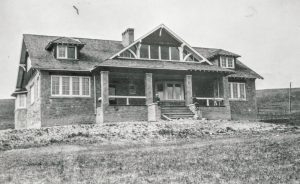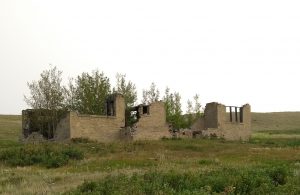In August, I had the rare opportunity to join a tour, offered by the Glenbow Ranch Park Foundation, to the ruins of a sandstone mansion. Located on private property bordering Glenbow Ranch Provincial Park, special permission from the land owner is required before one can access the site. One of a number of residences that graced Millionaires’ Hill, this ghost of a house is the most picturesque and evocative example of historic stately homes at Glenbow.
Ken Wright, a knowledgable and amiable park steward, led the tour to the ruins of the old Stevenson house. He, and several other stewards who were present, answered all kinds of questions and kindly shared information on various topics, including local history, plant identification, and photography. In all, ten of us set off from the parking lot, down into a coulee, through several fence lines, and upslope to the edge of the prairie level. From this perspective, I gained a new outlook on the Glenbow community.
Almost all of my time at the park has been spent in the valley, investigating the lives of the working class residents. However, there were upper-class Glenbow homeowners, as well. Chester Rhoades de la Vergne was a rich New Yorker who decided to take up sheep and horse ranching in the West on a part-time basis. By 1909, he owned the land beside the Glenbow Quarry and had the Glenbow townsite surveyed on his property. Chester eventually convinced several friends and relatives to join him at Glenbow. All but one of these built seasonal homes nearby on the highland, with its sweeping panorama of the valley and the mountains beyond. Consequently, the area became known as Millionaires’ Hill.
Chester’s wife, Gladys, was used to the finer things in life and required the construction of a new house before she would bring their children to Glenbow. This residence was built next door to the original homesteaders’ ranch house, which was the home of Chester’s ranching partner, Leonard Kennerley, who married Gladys’s sister, Celia. These structures are nestled at the top of a coulee in the centre of today’s park and are not accessible to visitors. One of Chester’s sisters (Mary) and her husband, Craig Drake, built a summer home a short distance away. The Drakes’ red barn is on private property and can be seen on the approach to today’s park entrance. Very near the Drake house was the residence of family friends, Dr. Dudley Morris and his wife, Gertrude. The remains of their home consist of two fireplace chimneys, now the focus of a modern picnic area located beside the park Interpretive Centre. Another New Yorker opted for a complete change of lifestyle, from stock broker to full-time rancher: John Hallett Clark and his wife, Sarah, moved permanently into the Bow Valley, just south of the Morris house. They bought Waverley Ranch, which had been homesteaded in 1893. A chimney is all that survives of their home and, although in a closed area, it is visible from the park trail.
The object of the tour, however, was the house of yet another wealthy New York family, George de St. Clair Stevenson and his wife, Kathleen. George was a British army officer and Kathleen was a New York society lady. They bought land in the Glenbow area and built a mansion in 1913, using sandstone quarried from the nearby cliff-line. So far, I have not been able to uncover as much as I would like about the Stevensons, but I do know George had a dragon tattooed on his left forearm. It is a quirk of documentary research that sometimes it is difficult to establish basic facts about a person’s life, while eccentric details have been preserved by chance.
After the Stevensons were recalled to Britain due to the Great War, they rented the house to Kathleen’s long-time friend, the heiress, Mrs. Gertrude Vanderhoef. Separated from her husband, she and her young daughter moved in. Gertrude lived extravagantly and threw lavish parties, serving large quantities of specially imported and prepared foods. Often, there were so many left-overs she would invite the neighbours the next day, and after greeting everyone, would leave her maids to perform as hosts. The local history book records several instances of mischief perpetrated on Mrs. Vanderhoef by the maid, Jenny, which suggests the locals did not empathize with the well-to-do mistress of the house.
Besides the social bonds of family and friendship, this intimate group of wealthy New Yorkers were tied together physically by a private telephone line strung between their houses. Their connections to Glenbow were not permanent, however. The decay of the local industry and the related economic depression, combined with the onset of the First World War, caused the residents of Millionaires’ Hill to drift back to their affluent urban lifestyle. Gertrude Vanderhoef had not known she was foreshadowing the demise of her residence when she held a themed party and had the house decorated with cobwebs and paper patches on the windows.

Stevenson home, circa 1920. Courtesy of Shirley Thomas.
On the morning I visited the Stevenson ruins, the smoke blanketing the province lent a mysterious cast to the landscape. As we approached the crumbling skeleton of a house, I was struck by its impressive size, which was heightened by its situation on the rising ground. We crept around the perimeter of the once grand home, gasping at the tumbled walls, still towering over our heads in places, with remnants of floors jutting into thin air. Peeking over the edge of the foundation into the basement, we could see traces of rusty metal among the shadows cast by the large trees that have taken root in the depression. We paused for photographs on the eerie stone stairs which lead from the exterior ground surface up into nowhere, marking the side entrance of the house, with an old boot-scraper anchored in the earth beside the bottom step.

Stevenson home, August 2018.
My visit to this abandoned mansion, with its melancholy aura of lost magnificence, allowed me to glimpse Glenbow from a different perspective. High above the valley, filled with its daily activity, I was encircled by open grasslands, far-reaching vistas, and silence. The only things in view approaching my elevation were the other sites of vanished opulence. I was part of a world above the ordinary. Perhaps this was how the elite of Glenbow saw themselves. The haze, which hung in the air like a veil between time, separated me from my normal experience and allowed me to peer into the past and imagine…
This article was originally printed in the Bergen News and is being reprinted with permission.